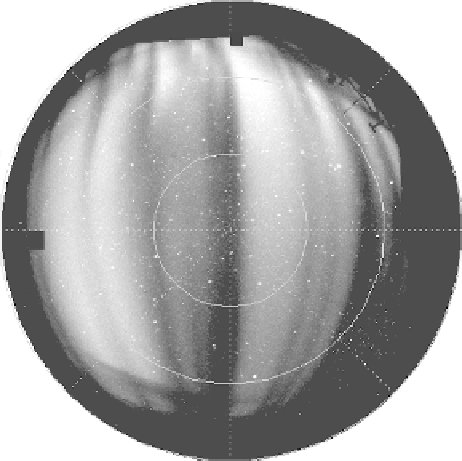Geoscience Reference
In-Depth Information
that the large-scale features remain in the medium long after the smallest struc-
tures disappear. Decaying neutral fluid turbulence also behaves in this man-
ner; that is, the shortest-scale features decay first when the driving forces are
removed.
Airglow observations have also proven to be quite valuable. Figure 4.7a shows
an image taken in the 630 nm emission due to excited atomic oxygen in the
thermosphere. This is emitted in the two-step recombination of O
+
discussed
in Chapter 1, which also yields a 557
7 nm emission (e.g., Fig. 4.7b). The dark
bands indicate regions that are either low in plasma density or high in altitude;
very likely both attributes contribute based on all of the other data shown in this
section. Figure 4.7b shows that plumes can extend to well over 1500 km. Here,
two CCD camera outputs are combined to show both the base of the equatorial
ionosphere and the plumes as they map to the ionosphere north of Hawaii.
Many bifurcations occur, and the plumes widen as they reach high equatorial
altitudes. Structure can be seen at the base of the ionosphere (see arrows). It
is important to note that the airglow over Hawaii, for example, is generated
locally. Thus, the structure observed must be created by electric fields mapped
from the high-altitude equatorial plane acting on the vertical gradient in the local
ionosphere.
.
Sept 28, 1995
N
W
E
S
Figure 4.7a
All-sky airglow image at 630 nm taken on Christmas Island during CEIS
conditions. (Figure courtesy of M. Taylor.)

Search WWH ::

Custom Search